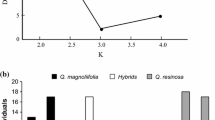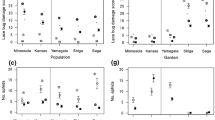Abstract
We studied herbivory of two species of willows (Salix sericea and S. eriocephala) and their interspecific hybrids to test alternative hypotheses concerning the effects of hybridization on plant resistance. Individually marked plants were identified using morphological traits in the field and random amplified polymorphic DNA (RAPD) band analysis was used to verify the genetic status of many parental and hybrid plants. The desities of 12 herbivore species on plants in the field were compared between two parents and their F2-type hybrids. We found about equal support for the additive, dominance, and hybrid susceptibility hypotheses over 4 years. In one year, one species supported the hybrid resistance hypothesis. Guild membership was not a good predictor of similar responses of species to hybrid versus parental plants. There were marked differences in support for particular hypotheses among years for four herbivore species. This study demonstrates the diversity of responses of phytophages in response to interspecific hybridization, and indicates that year-to-year variation in relative resistance of hybrid plants can be important.
Similar content being viewed by others
References
Aguilar JM, Boecklen WJ (1992) Patterns of herbivory in the Quercus grisea × Quercus gambelii species complex. Oikos 64:498–504
Argus GW (1974) An experimental study of hybridization and pollination in Salix (willows). Can J Bot 52:1613–1619
Argus GW (1986) The genus Salix (Salicaceae) in the southeastern United States. Syst Bot Monogr 9:1–170
Arnold ML, Hodges SA (1995) Are natural hybrids fit or unfit relative to their parents. Trends Ecol Evol 10:67–71
Berenbaum MR, Zangerl AR (1992) Genetics of secondary metabolism and herbivore resistance in plants. In: Rosenthal GA, Berenbaum MR (eds) Herbivores: their interactions with secondary plant metabolites. second edition, vol II. Evolutionary and ecological processes. Academic Press, San Diego, pp 415–438
Boecklen WJ, Larson KC (1994) Gall-forming wasps (Hymenoptera: Cynipidae) in an oak hybrid zone: testing hypotheses about hybrid susceptibility to herbivores. In: Price PW, Mattson WJ, Baranchikoy YN (eds) The ecology and evolution of gall-forming insects. North Central Forest Experiment Station, Forest Service USDA, St. Paul, pp 110–120
Boeklen WJ, Spellenberg R (1990) Structure of herbivore communities in two oak (Quercus spp.) hybrid zones. Oecologia 85:92–100
Cruzan MB, Arnold ML (1993) Ecological and genetic associations in an Iris hybrid zone. Evolution 47:1432–1445
Fritz RS, Nichols-Orians CM, Brunsfeld SJ (1994) Interspecific hybridization of plants and resistance to herbivores: Hypotheses, genetics, and variable responses in a diverse community. Oecologia 97:106–117
Grant V (1981) Plant speciation, 2nd ed. Columbia University Press, New York
Hall RW, Townsend AM (1987) Suitability of Ulmus wilsoniana, the ‘urban’ elm, and their hybrids for the elm leaf beetle, Xanthogaleruca luteola (Müller) (Coleoptera: Chrysomelidae). Environ Entomol 16:1042–1044
Hanhimäki S, Senn J, Haukioja E (1994) Performance of insect hebivores on hybridising trees: the case of the subarctic birches. J Anim Ecol 63:163–175
Huesing J, Jones D, Deveerna J, Myers J, Collins G, Severson R, Sisson V (1989) Biochemical investigations of antibiosis material in leaf exudate of wild Nicotiana species and interspecific hybrids. J Chem Ecol 15:1203–1217
Keim P, Paige KN, Whitham TG, Lark KG (1989) Genetic analysis of an interspecific swarm of Populus: occurrence of unidirectional introgression. Genetics 123:557–565
Levy A, Milo J (1991) Inheritance of morphological and chemical characters in interspecific hybrids between Papaver bracteatum and Papaver pseudo-orientale. Theor Appl Genet 81: 537–540
Meier B, Bettschart A, Shao Y, Lautenschlager E (1989) Einsatz der modernen HPLC für chemotaxonomische Untersuchungen morphologisch schwer zu differenzierender Salix-Hybriden. Planta Med 55:213–214
Morrow PA, Whitham TG, Potts BM, Ladiges P, Ashton DH, Williams JB (1994) Gall-forming insects concentrate on hybrid phenotypes of Eucalyptus. In: Price PW, Mattson WJ, Baranchikov YN (eds) The ecology and evolution of gall-forming insects. North Central Forest Experiment Station, Forest Service USDA, St. Paul, pp 121–134
Mosseler A, Papadopol CS (1989) Seasonal isolation as a reproductive barrier among sympatric Salix species. Can J Bot 67: 2563–2570
O'Donoughue LS, Raelson JV, Grant WF (1990) A morphological study of interspecific hybrids in the genus Lotus (Fabaceae). Can J Bot 68:803–812
Orians CM, Fritz RS (1995) Secondary chemistry of hybrid and parental willows: phenolic glycosides and condensed tannins in Salix sericea, S. eriocephala, and their hybrids. J Chem Ecol 21:1245–1253
Paige KN, Capman WC (1993) The effects of host-plant genotype, hybridization and environment on gall aphid attack and survival in cottonwood: the importance of genetic studies and the utility of RFLPs. Evolution 47:36–45
Paige KN, Capman WC, Jennetten P (1991) Mitochondrial inheritance patterns across a cottonwood hybrid zone: cytonuclear disequilibria and hybrid zone dynamics. Evolution 45:1360–1369
Rieseberg LH, Brunsfeld SJ (1992) Molecular evidence and plant introgression. In: Soltis PS, Soltis DE, Doyle JD (eds) Molecular systematics of plants, Chapman and Hall, New York, pp 151–176
Rieseberg LH, Ellstrand NC (1993) What can molecular and morphological markers tell us about plant hybridization? Crit Rev Plant Sci 12:213–241
Rieseberg LH, Wendel JF (1993) Introgression and its consequences in plants. In: Harrison RG (ed) Hybrid zones and the evolutionary process. Oxford University Press, New York, pp 70–109
SAS Institute (1985) SAS user's guide: Statistics, version 5 ed. SAS Institute, Cary
Soetens P, Rowell-Rahier M, Pasteels JM (1991) Influence of phenolglucosides and trichome density on the distribution of insects herbivores on willows. Entomol Exp Appl 59:175–187
Strauss SY (1994) Levels of herbivory and parasitism in host hybrid zones. Trends Ecol Evol 9:209–214
Whitham TG (1989) Plant hybrid zones as sinks for pests. Science 244:1490–1493
Whitham TG, Morrow PA, Potts BM (1991) Conservation of hybrid plants. Science 254:779–780
Whitham TG, Morrow PA, Potts BM (1994) Plant hybrid zones as centers of biodiversity: the herbivore community of two endemic Tasmanian eucalypts. Oecologia 97:481–490
Author information
Authors and Affiliations
Corresponding author
Rights and permissions
About this article
Cite this article
Fritz, R.S., Roche, B.M., Brunsfeld, S.J. et al. Interspecific and temporal variation in herbivore responses to hybrid willows. Oecologia 108, 121–129 (1996). https://doi.org/10.1007/BF00333223
Received:
Accepted:
Issue Date:
DOI: https://doi.org/10.1007/BF00333223




